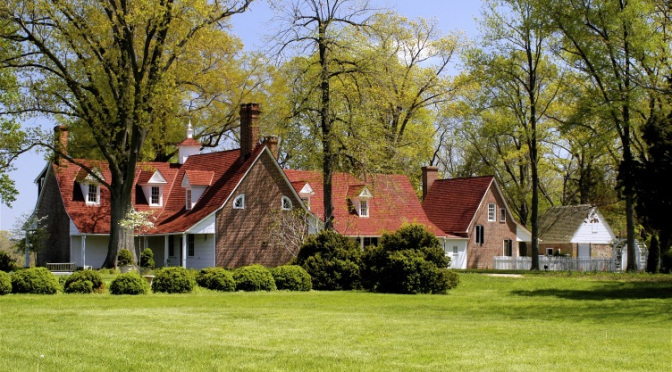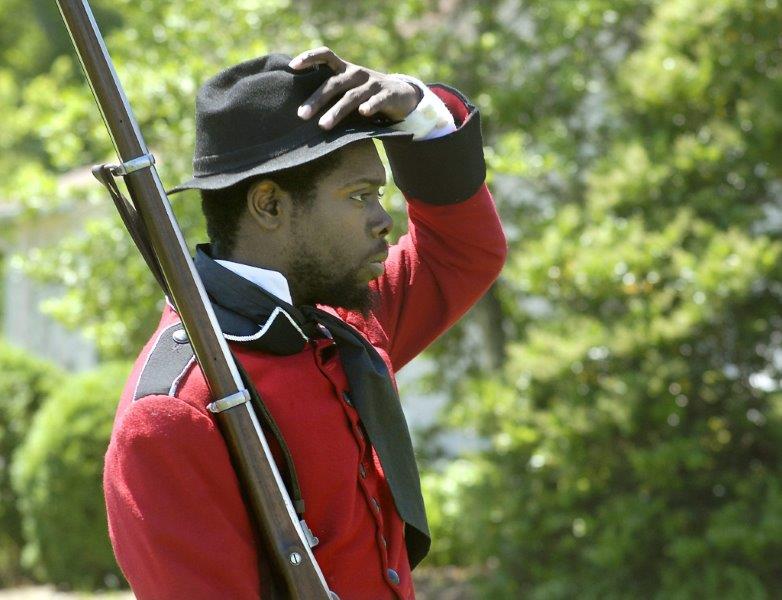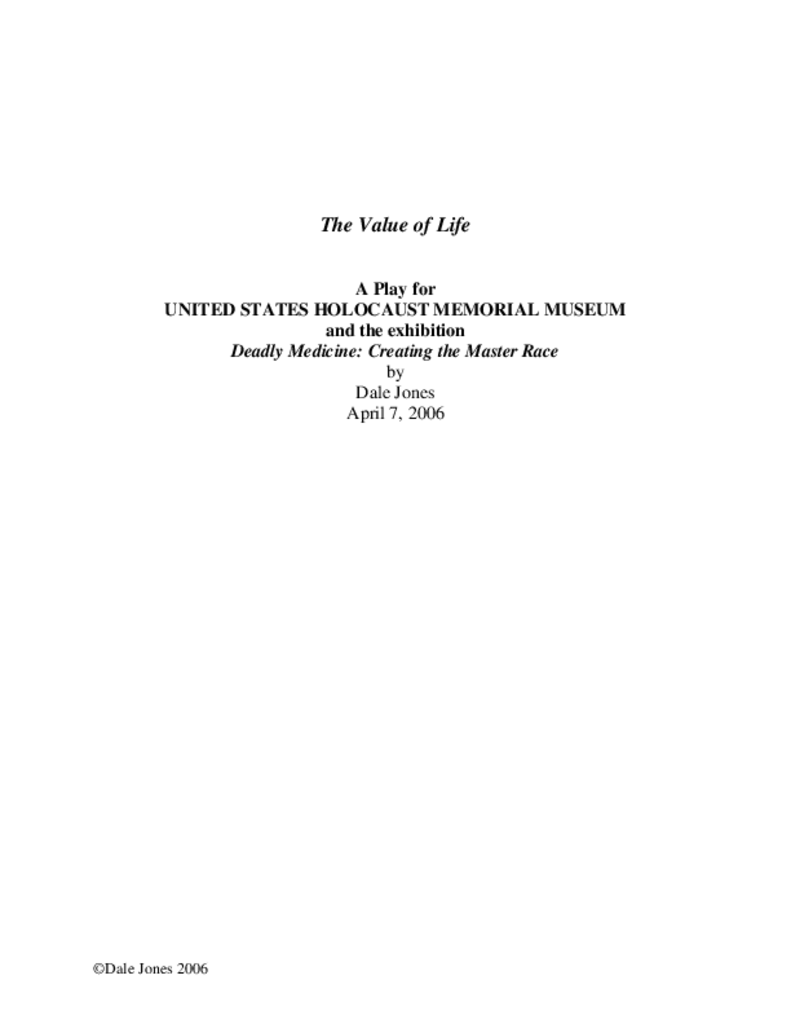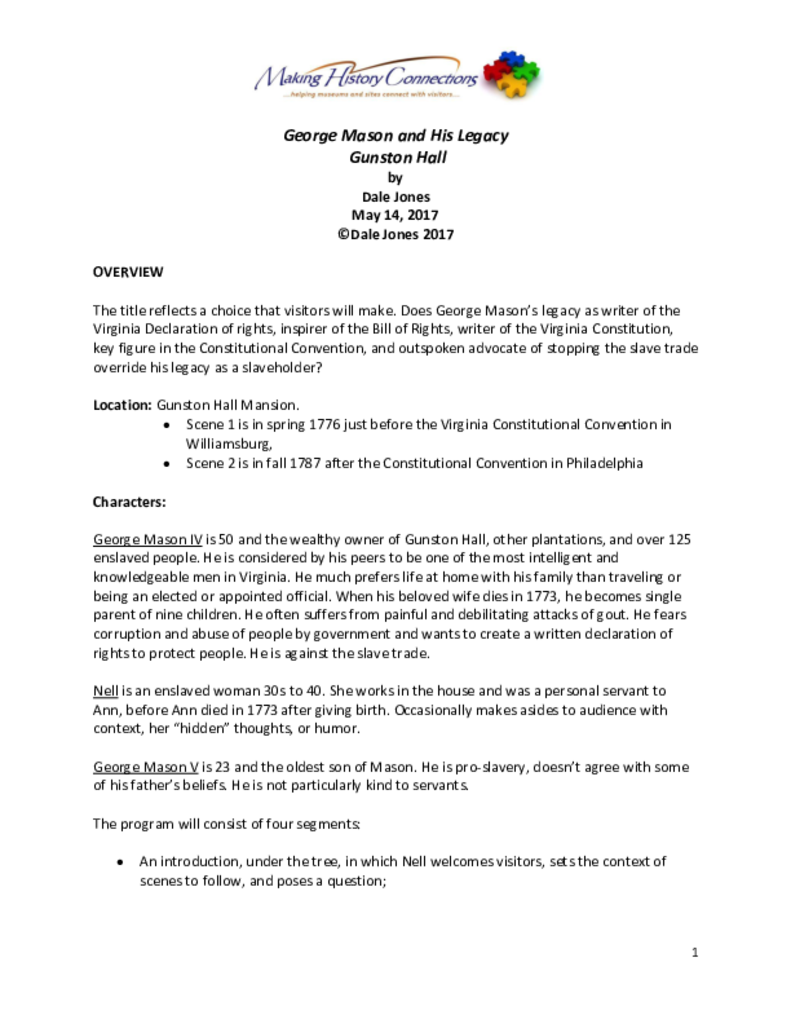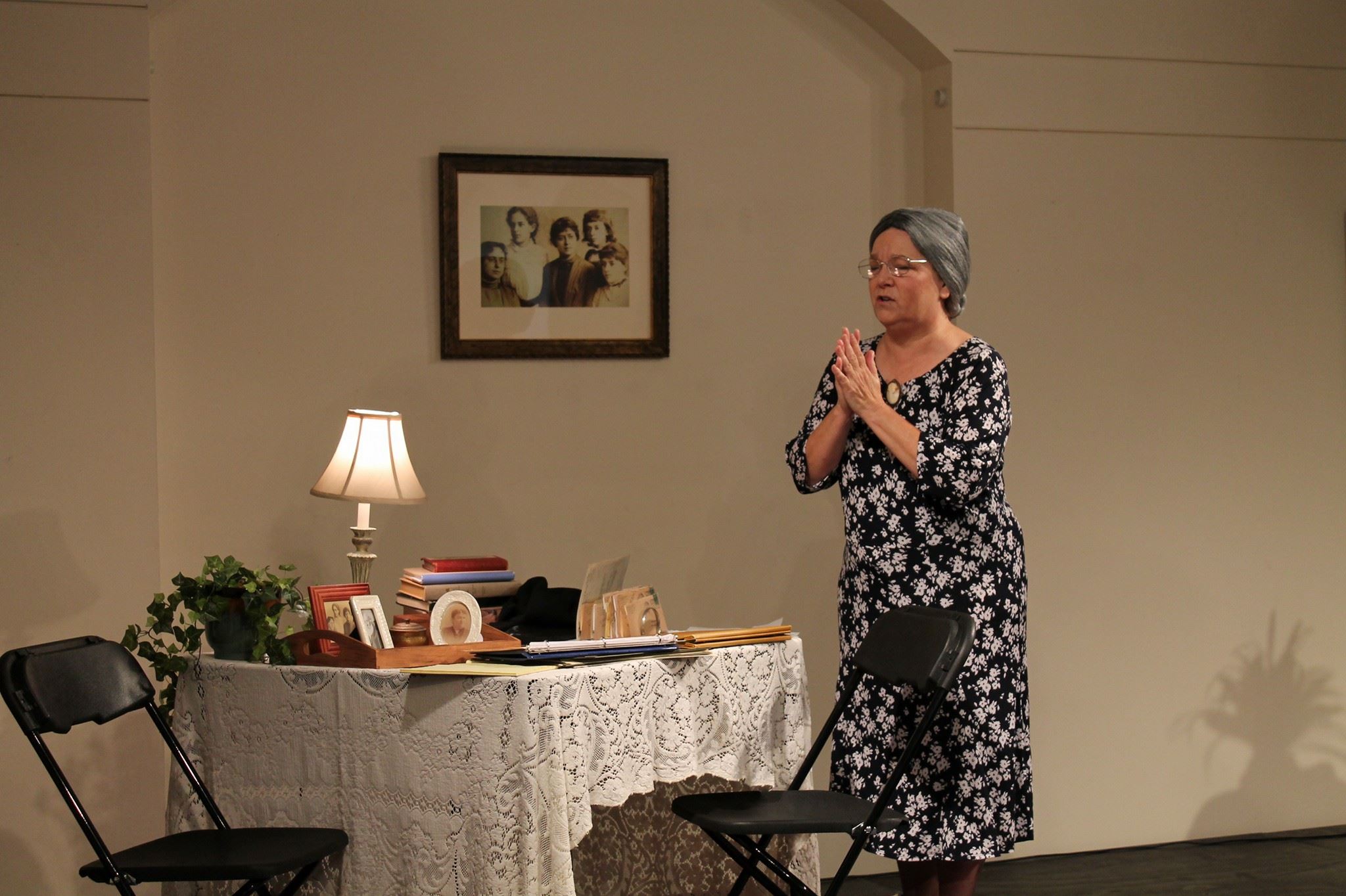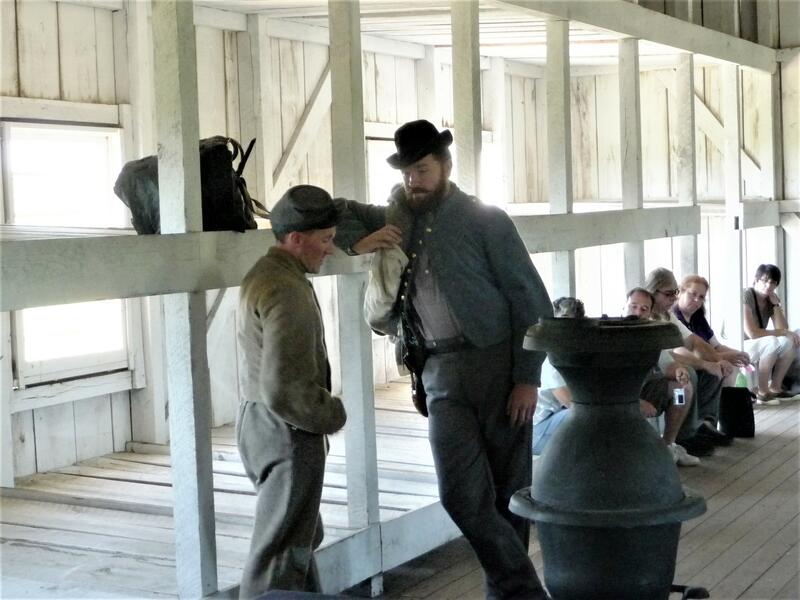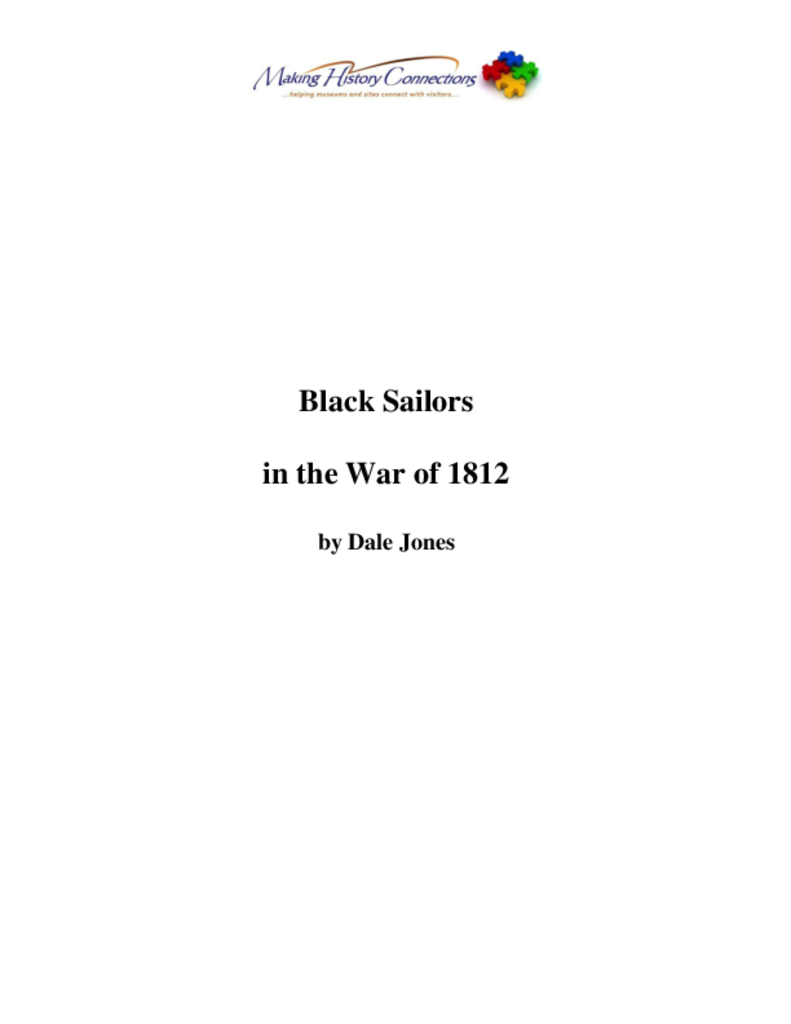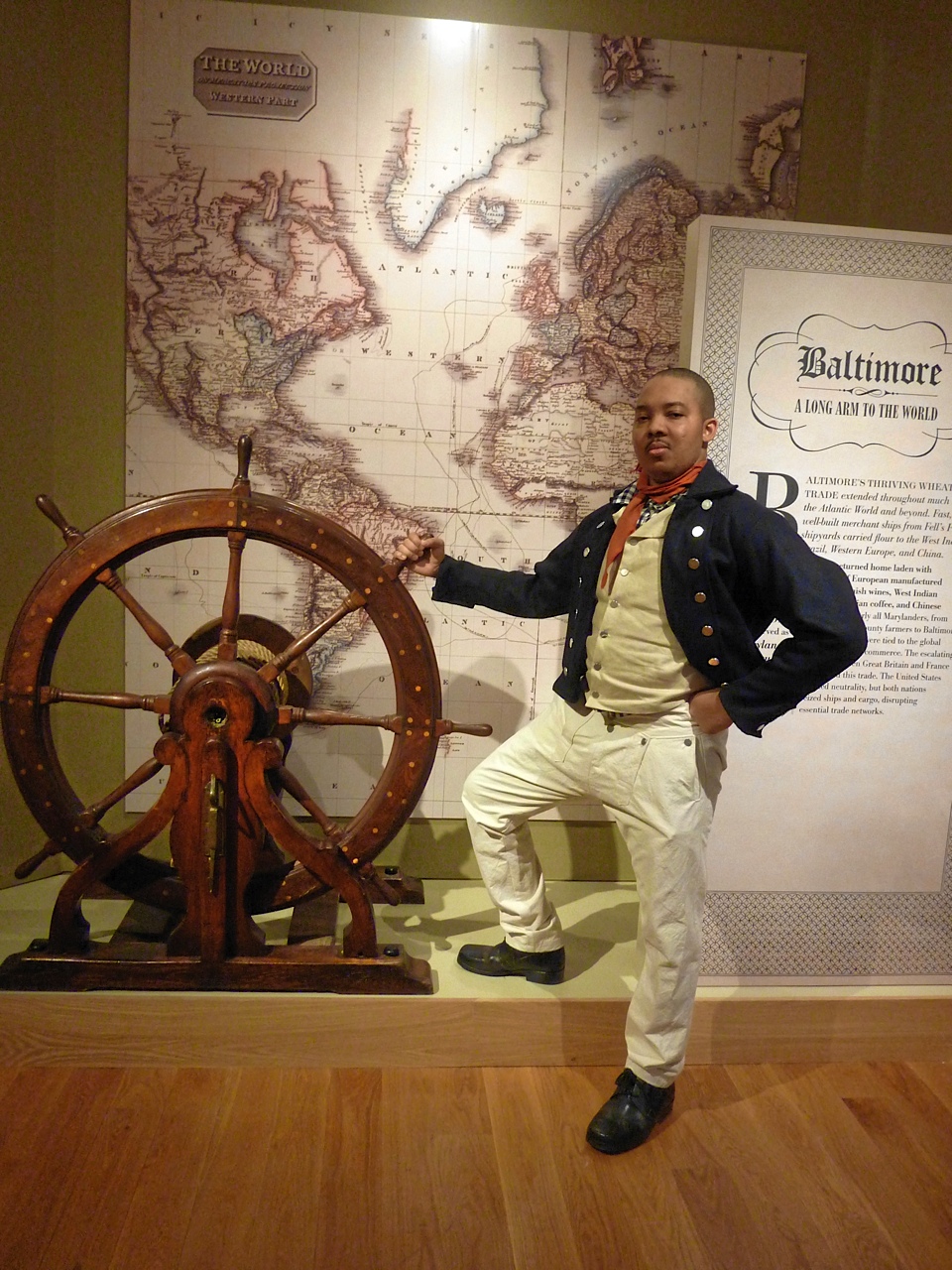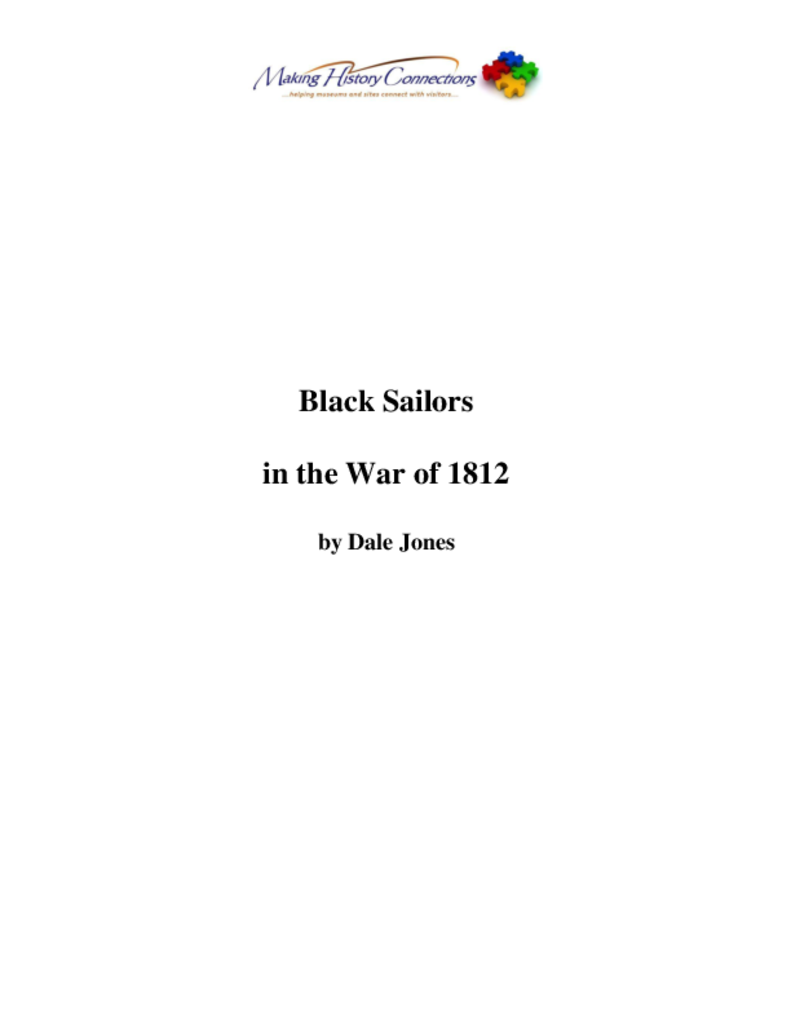Work samples
-
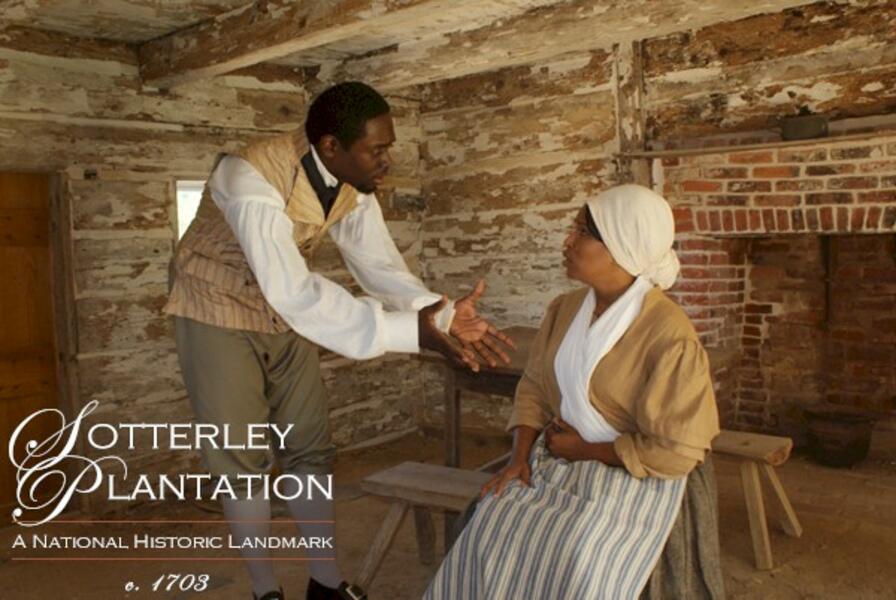 "The Choice" actors in slave cabin“The Choice -- Risking Your Life for Freedom,” tells the story of enslaved men, women and children during the War of 1812. As British warships sailed up the Patuxent River burning houses on Maryland’s Eastern Shore, the enslaved people living on Sotterley Plantation had a choice to make. Do they pursue their freedom by joining the British enemy? Or are the risks too great? As the audience moves from the "Big House" to the slave quarters, they are immersed in the lives of both black and white Marylanders as they struggle to understand the War’s impact on their freedom and survival.
"The Choice" actors in slave cabin“The Choice -- Risking Your Life for Freedom,” tells the story of enslaved men, women and children during the War of 1812. As British warships sailed up the Patuxent River burning houses on Maryland’s Eastern Shore, the enslaved people living on Sotterley Plantation had a choice to make. Do they pursue their freedom by joining the British enemy? Or are the risks too great? As the audience moves from the "Big House" to the slave quarters, they are immersed in the lives of both black and white Marylanders as they struggle to understand the War’s impact on their freedom and survival. -
Holocaust image.JPG"The Value of Life" explores how ordinary citizens in 1933 Germany willingly participated in the horror of “cleansing” society by murdering their own elderly and disabled citizens. Through four scenes based on actual events, actors delve into how that could happen. The United States Holocaust Memorial Museum commissioned the play as part of its exhibition "Deadly Medicine: Creating the Master Race exhibition."
-
 "George Mason and His Legacy" at Gunston Hall VA“George Mason and His Legacy” is an immersive performance at Gunston Hall in Northern Virginia. George Mason, his son, and their enslaved housekeeper Nell, confront the difficult issues of freedom, individual rights, and slavery from three very different viewpoints in the late 1700’s. This performance inspires visitors to experience their story and then discuss the democratic ideals that Mason and his contemporaries faced as they wrote the Constitution of the new United States.
"George Mason and His Legacy" at Gunston Hall VA“George Mason and His Legacy” is an immersive performance at Gunston Hall in Northern Virginia. George Mason, his son, and their enslaved housekeeper Nell, confront the difficult issues of freedom, individual rights, and slavery from three very different viewpoints in the late 1700’s. This performance inspires visitors to experience their story and then discuss the democratic ideals that Mason and his contemporaries faced as they wrote the Constitution of the new United States. -
"Citizens at the Crossroads" is performed in exhibition displays like this one depicting the wounded soldiers in the Seminary.The battle of Gettysburg was terrible for the people who lived there. “Citizens at the Crossroads” follows two residents who survived the battle only to face its devastating aftermath. A mother of young children and a free black man endure different but similarly horrific experiences. Actors perform at the Seminary Ridge Museum in Gettysburg among realistic sets depicting the horrors of war.
About Dale
Howard County

I create and direct compelling and provocative historical performances for museums that bring to life conflicts and complex issues from the past. I call these works “plays of conscience” because they feature real people and issues from history that help contemporary audiences understand controversial and sensitive issues that are relevant today.
These engaging and historically accurate re-enactments resonate deeply with audiences, and have produced meaningful follow up discussions… more
These engaging and historically accurate re-enactments resonate deeply with audiences, and have produced meaningful follow up discussions… more
Jump to a project:
The Choice -- Risking Your Life for Freedom
The Choice -- Risking Your Life for Freedom, tells the story of enslaved men, women and children during the War of 1812. As British warships sailed up the Patuxent River burning houses on Maryland’s Eastern Shore, the enslaved people living on Sotterley Plantation had a choice to make. Do they pursue their freedom by joining the British enemy? Or are the risks too great? As the audience moves from the "Big House" to the slave quarters, they are immersed in the lives of both black and white Marylanders as they struggle to understand the War’s impact on their freedom and survival.
To read the Slave Cabin scene from The Choice -- Risking Your Life for Freedom see the attachment.
To read the Slave Cabin scene from The Choice -- Risking Your Life for Freedom see the attachment.
-
 Historic Sotterley Plantation, St. Mary's County, MarylandAs British ships burned Eastern Shore plantations during the War of 1812, the enslaved people living there had to decide whether to flee. "The Choice: Risking Your Life for Freedom," tells their story. Audiences move with the performers from the main house to the slave cabin as the scenes unfold.
Historic Sotterley Plantation, St. Mary's County, MarylandAs British ships burned Eastern Shore plantations during the War of 1812, the enslaved people living there had to decide whether to flee. "The Choice: Risking Your Life for Freedom," tells their story. Audiences move with the performers from the main house to the slave cabin as the scenes unfold. -
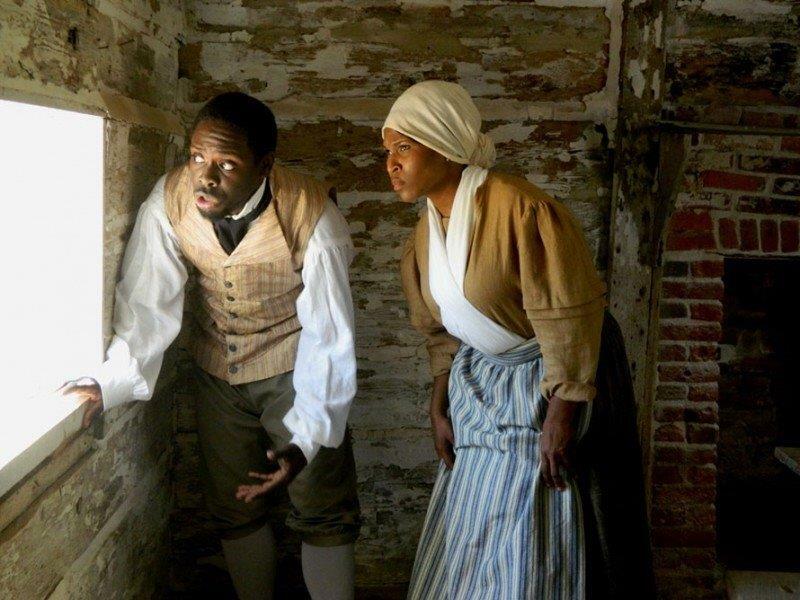 The Choice -- Risking Your Life for FreedomTwo enslaved house servants debate whether to make a run to the British, who offer freedom to slaves who escape their masters. But they fear getting caught if they try.
The Choice -- Risking Your Life for FreedomTwo enslaved house servants debate whether to make a run to the British, who offer freedom to slaves who escape their masters. But they fear getting caught if they try. -
 The Choice -- Risking Your Life for FreedomAn enslaved house servant escapes his Eastern Shore plantation to join the British Colonial Marines and earn his freedom during the War of 1812. He later confronts his former master while in uniform.
The Choice -- Risking Your Life for FreedomAn enslaved house servant escapes his Eastern Shore plantation to join the British Colonial Marines and earn his freedom during the War of 1812. He later confronts his former master while in uniform.
The Value of Life
How could ordinary citizens living in 1933 Germany willingly participate in “cleansing” society by murdering their own elderly and disabled citizens? The United States Holocaust Memorial Museum in Washington, DC examines the “how and why” behind that troubling question through a historical performance The Value of Life.
The museum’s exhibition “Deadly Medicine: Creating the Master Race,” explores Nazi Germany’s campaign to “cleanse” German society of people viewed as biological threats to the nation’s “health” and traces this history from the early 20th-century international eugenics movement to the Nazi regime’s “science of race.”
I was commissioned to write and direct a play performed in conjunction with the “Deadly Medicine” exhibition at the Holocaust Museum in 2006. The Value of Life demonstrates how someone’s personal values can be tested and changed over time.
The play, based on actual events, portrays a nurse working in a German medical center that houses disabled children, older adults and other “undesirables” before they are put to death by the State. It addresses her moral dilemma – follow her supervisor’s orders to administer lethal medicine to the patients under her care, or disobey orders and risk the wrath of those in charge.
The scene then shifts to a year later, as the Center celebrates the death of its 10,000 victim with a party. The medical staff ceremoniously adorns their victims’ body with flowers and swastikas before shoving it into the ovens. The nurse, now a willing participant, reflects back on the past year, as she confronts her own personal role in the eugenics movement, and the death of the patients under her care.
As the play comes to a close, the main character realizes that…
“If I don’t want to be a bystander, if I don’t want to be one of those who contribute to others’ suffering, if I don’t want any of that to happen, I have to be vigilant. I have to remember my values, take them out often, examine them, and make sure that they are sound. And then hope that I have the courage to use them when it’s time to do the right thing.”
The Value of Life has been performed over 150 times for over 7000 Holocaust Museum visitors. It addresses a disturbing topic, and yet has had a tremendous impact on those who have witnessed this drama in person. It effectively illustrates how “plays of conscience” can use historical events to convey controversial themes and concepts from the past that still resonate in the present.
To read Scenes 1 & 2 from "The Value of Life" see the attachment.
The museum’s exhibition “Deadly Medicine: Creating the Master Race,” explores Nazi Germany’s campaign to “cleanse” German society of people viewed as biological threats to the nation’s “health” and traces this history from the early 20th-century international eugenics movement to the Nazi regime’s “science of race.”
I was commissioned to write and direct a play performed in conjunction with the “Deadly Medicine” exhibition at the Holocaust Museum in 2006. The Value of Life demonstrates how someone’s personal values can be tested and changed over time.
The play, based on actual events, portrays a nurse working in a German medical center that houses disabled children, older adults and other “undesirables” before they are put to death by the State. It addresses her moral dilemma – follow her supervisor’s orders to administer lethal medicine to the patients under her care, or disobey orders and risk the wrath of those in charge.
The scene then shifts to a year later, as the Center celebrates the death of its 10,000 victim with a party. The medical staff ceremoniously adorns their victims’ body with flowers and swastikas before shoving it into the ovens. The nurse, now a willing participant, reflects back on the past year, as she confronts her own personal role in the eugenics movement, and the death of the patients under her care.
As the play comes to a close, the main character realizes that…
“If I don’t want to be a bystander, if I don’t want to be one of those who contribute to others’ suffering, if I don’t want any of that to happen, I have to be vigilant. I have to remember my values, take them out often, examine them, and make sure that they are sound. And then hope that I have the courage to use them when it’s time to do the right thing.”
The Value of Life has been performed over 150 times for over 7000 Holocaust Museum visitors. It addresses a disturbing topic, and yet has had a tremendous impact on those who have witnessed this drama in person. It effectively illustrates how “plays of conscience” can use historical events to convey controversial themes and concepts from the past that still resonate in the present.
To read Scenes 1 & 2 from "The Value of Life" see the attachment.
-
"The Value of Life" performed at the Holocaust MuseumA German nurse morally struggles with her supervisor’s orders to euthanize children at the Hadamar Pediatric Center in Nazi Germany, a killing site where Germans murdered their own “undesirable” citizens beginning in the early 1930s.
-
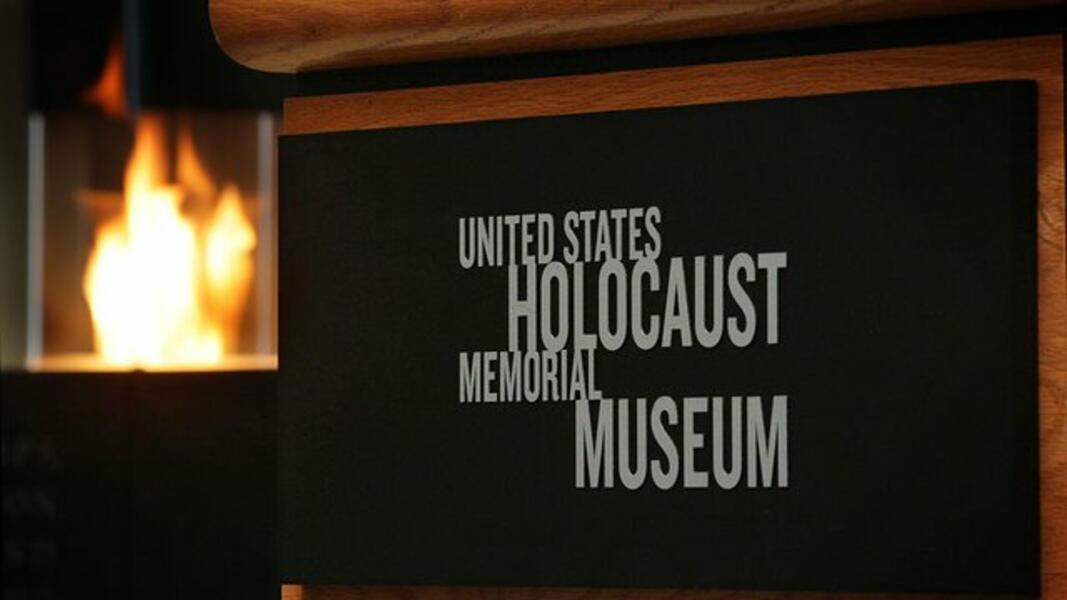 United States Holocaust Memorial MuseumThe United State Holocaust Memorial Museum where "The Value of Life" was first performed.
United States Holocaust Memorial MuseumThe United State Holocaust Memorial Museum where "The Value of Life" was first performed. -
 Deadly Medicine exhibit posterThe "Value of Life" was part of the Deadly Medicine exhibit at the United States Holocaust Memorial Museum. Deadly Medicine told the story of how Germans murdered their own citizens they considered unworthy of life. The play looks at how ordinary people become participants in the killing.
Deadly Medicine exhibit posterThe "Value of Life" was part of the Deadly Medicine exhibit at the United States Holocaust Memorial Museum. Deadly Medicine told the story of how Germans murdered their own citizens they considered unworthy of life. The play looks at how ordinary people become participants in the killing.
George Mason and His Legacy
George Mason and his Legacy, performed at Gunston Hall in Northern Virginia, immerses visitors into the complex relationships of master and enslaved. George Mason, his son, and their enslaved housekeeper Nell confront the difficult issues of freedom, individual rights, and slavery from three very different viewpoints in the late 1700s. This performance inspires visitors to experience their stories and then discuss the democratic ideals that Mason and his contemporaries faced as they wrote the Constitution of the new United States.
Characters:
George Mason IV is the 50 year old wealthy owner of Gunston Hall, as well as several other plantations. He is also the owner of more than 125 enslaved people. He is considered to be one of the most intelligent and knowledgeable men in Virginia, and will travel to Philadelphia to help create the Constitution of his country. He fears “corruption and abuse of the people by the government” and therefore wants to include in the constitution a written declaration of human rights to protect the citizens of the new United States of America. He is adamantly opposed to the slave trade.
Nell is an enslaved woman in her late 30s. She works in the house for the Mason family and silently submits to Mason and his son’s commands. But that doesn’t prevent Nell from making occasional “asides” directly to the audience…offering her “hidden” thoughts, a humorous take, or a completely different perspective of the issue at hand.
George Mason V is 23 years old and Mason’s eldest son. He is pro-slavery, and doesn’t agree with some of his father’s more radical anti-slavery beliefs. He is not particularly kind to servants.
Structure for “George Mason and his Legacy”:
Introduction: Nell welcomes visitors outside the house, sets the context of scenes to follow, and poses a question the audience will address later after seeing scenes providing them insight:
What is George Mason’s legacy? Is it as a patriotic Founding Father, author of Virginia’s Constitution, inspiration for the US Bill of Rights and outspoken advocate against the slave trade of the late 18th century? Or, is his political legacy overshadowed by his legacy as a slaveholder?
She then leads visitors into the house for Scenes One and Two.
Scene One, spring 1776: George Mason V is trying to persuade his father to attend the Virginia Convention, where he will ultimately draft the Virginia Declaration of Rights and the Virginia Constitution;
Scene Two, fall 1787: George Mason IV has recently returned from the Constitutional Convention in Philadelphia and will oppose the ratification of the US Constitution since it does not include a Bill of Rights. His son cannot understand why his father would not sign the Constitution, even without a Bill of Rights.
Conclusion: Nell leads the audience back outside, and facilitates an interactive discussion with the audience. She allows them to reflect on what they have seen and challenges them to consider how the Founding Fathers viewed democracy. Finally, the audience shares feedback on how they view George Mason’s legacy.
During the scenes in the house, visitors, who are within several feet of the actors, see Mason eloquently argue that the Constitution of the United States must protect the rights of all men, including slaves, while his own family’s female slave stands patiently nearby – practically invisible to him and his son (but certainly not to the audience). In several scenes, the action freezes, and Nell steps forward to offer her thoughts about freedom and how she is treated – usually at odds with how both Masons are thinking and speaking. Her comments are funny, incisive, and ultimately poignant.
My goal in writing and directing was to put visitors intimately “in the moment” in two events in George Mason’s life. By understanding the background of these moments and hearing discussion of ideas significant to our democracy, I hope to give participants the opportunity to consider the value and importance of the ideas espoused by Mason. By seeing dramatic museum theatre performances, hearing the words of Mason and discussing implications of his ideas and answering the question about his legacy (posed to them at the beginning by Nell), visitors will develop a deeper understanding of the beginnings of our government and the ideas that continue to shape it today.
To read an excerpt from "George Mason and His Legacy" please see attachment.
Characters:
George Mason IV is the 50 year old wealthy owner of Gunston Hall, as well as several other plantations. He is also the owner of more than 125 enslaved people. He is considered to be one of the most intelligent and knowledgeable men in Virginia, and will travel to Philadelphia to help create the Constitution of his country. He fears “corruption and abuse of the people by the government” and therefore wants to include in the constitution a written declaration of human rights to protect the citizens of the new United States of America. He is adamantly opposed to the slave trade.
Nell is an enslaved woman in her late 30s. She works in the house for the Mason family and silently submits to Mason and his son’s commands. But that doesn’t prevent Nell from making occasional “asides” directly to the audience…offering her “hidden” thoughts, a humorous take, or a completely different perspective of the issue at hand.
George Mason V is 23 years old and Mason’s eldest son. He is pro-slavery, and doesn’t agree with some of his father’s more radical anti-slavery beliefs. He is not particularly kind to servants.
Structure for “George Mason and his Legacy”:
Introduction: Nell welcomes visitors outside the house, sets the context of scenes to follow, and poses a question the audience will address later after seeing scenes providing them insight:
What is George Mason’s legacy? Is it as a patriotic Founding Father, author of Virginia’s Constitution, inspiration for the US Bill of Rights and outspoken advocate against the slave trade of the late 18th century? Or, is his political legacy overshadowed by his legacy as a slaveholder?
She then leads visitors into the house for Scenes One and Two.
Scene One, spring 1776: George Mason V is trying to persuade his father to attend the Virginia Convention, where he will ultimately draft the Virginia Declaration of Rights and the Virginia Constitution;
Scene Two, fall 1787: George Mason IV has recently returned from the Constitutional Convention in Philadelphia and will oppose the ratification of the US Constitution since it does not include a Bill of Rights. His son cannot understand why his father would not sign the Constitution, even without a Bill of Rights.
Conclusion: Nell leads the audience back outside, and facilitates an interactive discussion with the audience. She allows them to reflect on what they have seen and challenges them to consider how the Founding Fathers viewed democracy. Finally, the audience shares feedback on how they view George Mason’s legacy.
During the scenes in the house, visitors, who are within several feet of the actors, see Mason eloquently argue that the Constitution of the United States must protect the rights of all men, including slaves, while his own family’s female slave stands patiently nearby – practically invisible to him and his son (but certainly not to the audience). In several scenes, the action freezes, and Nell steps forward to offer her thoughts about freedom and how she is treated – usually at odds with how both Masons are thinking and speaking. Her comments are funny, incisive, and ultimately poignant.
My goal in writing and directing was to put visitors intimately “in the moment” in two events in George Mason’s life. By understanding the background of these moments and hearing discussion of ideas significant to our democracy, I hope to give participants the opportunity to consider the value and importance of the ideas espoused by Mason. By seeing dramatic museum theatre performances, hearing the words of Mason and discussing implications of his ideas and answering the question about his legacy (posed to them at the beginning by Nell), visitors will develop a deeper understanding of the beginnings of our government and the ideas that continue to shape it today.
To read an excerpt from "George Mason and His Legacy" please see attachment.
-
 Gunston Hall, Mason Neck, VAGunston Hall is home of George Mason, Father of the Bill of Rights
Gunston Hall, Mason Neck, VAGunston Hall is home of George Mason, Father of the Bill of Rights -
 George Mason and His LegacyGeorge Mason is a major Virginia slaveholder, but he also opposes the slave trade. His son supports slavery, and believes it has given them their status and wealth. Mason argues with his son that the new Constitution needs a Bill of Rights for all men.
George Mason and His LegacyGeorge Mason is a major Virginia slaveholder, but he also opposes the slave trade. His son supports slavery, and believes it has given them their status and wealth. Mason argues with his son that the new Constitution needs a Bill of Rights for all men. -
 Nell, George Mason’s house servantFollowing the performance, Nell leads an interactive discussion with the audience about democracy and freedom.
Nell, George Mason’s house servantFollowing the performance, Nell leads an interactive discussion with the audience about democracy and freedom.
Citizens at the Crossroads
The battle of Gettysburg was horrific for not only the soldiers who fought there, but also for the residents who lived there. Citizens at the Crossroads looks at two Gettysburg residents who survived the battle only to face its devastating aftermath. Mary Ziegler, a white woman, and Basil Biggs, a black man, endured different but similarly dreadful experiences.
Mary lived west of town at the Lutheran Theological Seminary, where she was matron of the college and oversaw food and housekeeping for the seminarians. On the first day of the battle, Union and Confederate troops clashed outside on the grounds of the Seminary. Mary was able to safely flee the scene with her two young children. But when they tried to return several days later, the streets were nearly impassable. They struggled to step around unexploded munitions, and dodged dead and wounded soldiers as well as thousands of dead and rotting horses that blocked their slow progress home.
Mary finally arrives back at the Seminary to find that the building, including her family’s private rooms, have been turned into a hospital with 600 dying and wounded soldiers scattered on the beds and floors throughout. It was a shocking and gruesome sight. Mary’s profound dilemma: “Should she stay and help the ailing soldiers and assist the sparse medical staff, or should she leave immediately with her children to spare them the unspeakable horrors unfolding under their roof?” She examines her heart and values and decides that she must help, and so she stays.
Basil, a farmer, veterinarian and free black man, was a prominent member of the black community in Gettysburg. He faced a different but equally harrowing situation. Prior to the battle, Confederate raiders were riding through Gettysburg capturing any black men, women, and children they could find, both free and fugitives from slavery. They marched them all south in chains as prisoners, to be sold into slavery. Basil was able to send his family away to safety, but he opted to stay in town. Finally, as Confederate troops threatened to take the town from the west, he borrowed a horse and fled east.
After the battle, he returns with his family to find a totally destroyed farm. He too was faced with a decision: “Should we stay here and rebuild, or do we leave everything behind to start over in a safer place?” He decides to stay and make the best of it as he rebuilds his home and helps the devastated town begin to recover.
In writing and directing Citizens at the Crossroads I hoped to immerse visitors in the harrowing experiences and demanding choices the people of Gettysburg faced before, during and after the battle. The performance, staged inside Seminary among reproductions depicting the horrific scenes following the battle, helps visitors understand how residents responded to, and managed to survive, the horrible aftermath of the three day battle that nearly destroyed their town.
While many visitors are drawn to Gettysburg to learn about battle strategies, troop movements, and famous generals who fought in the war, Citizens at the Crossroads at the Seminary Ridge Museum helps visitors experience the war from an ordinary citizen’s perspective. Witnessing how others react in the face of terrible adversity 150 years ago, participants have the unique opportunity to consider how they might have responded then, and also how they might respond now, if a similar tragedy were to befall them in our current times.
Mary lived west of town at the Lutheran Theological Seminary, where she was matron of the college and oversaw food and housekeeping for the seminarians. On the first day of the battle, Union and Confederate troops clashed outside on the grounds of the Seminary. Mary was able to safely flee the scene with her two young children. But when they tried to return several days later, the streets were nearly impassable. They struggled to step around unexploded munitions, and dodged dead and wounded soldiers as well as thousands of dead and rotting horses that blocked their slow progress home.
Mary finally arrives back at the Seminary to find that the building, including her family’s private rooms, have been turned into a hospital with 600 dying and wounded soldiers scattered on the beds and floors throughout. It was a shocking and gruesome sight. Mary’s profound dilemma: “Should she stay and help the ailing soldiers and assist the sparse medical staff, or should she leave immediately with her children to spare them the unspeakable horrors unfolding under their roof?” She examines her heart and values and decides that she must help, and so she stays.
Basil, a farmer, veterinarian and free black man, was a prominent member of the black community in Gettysburg. He faced a different but equally harrowing situation. Prior to the battle, Confederate raiders were riding through Gettysburg capturing any black men, women, and children they could find, both free and fugitives from slavery. They marched them all south in chains as prisoners, to be sold into slavery. Basil was able to send his family away to safety, but he opted to stay in town. Finally, as Confederate troops threatened to take the town from the west, he borrowed a horse and fled east.
After the battle, he returns with his family to find a totally destroyed farm. He too was faced with a decision: “Should we stay here and rebuild, or do we leave everything behind to start over in a safer place?” He decides to stay and make the best of it as he rebuilds his home and helps the devastated town begin to recover.
In writing and directing Citizens at the Crossroads I hoped to immerse visitors in the harrowing experiences and demanding choices the people of Gettysburg faced before, during and after the battle. The performance, staged inside Seminary among reproductions depicting the horrific scenes following the battle, helps visitors understand how residents responded to, and managed to survive, the horrible aftermath of the three day battle that nearly destroyed their town.
While many visitors are drawn to Gettysburg to learn about battle strategies, troop movements, and famous generals who fought in the war, Citizens at the Crossroads at the Seminary Ridge Museum helps visitors experience the war from an ordinary citizen’s perspective. Witnessing how others react in the face of terrible adversity 150 years ago, participants have the unique opportunity to consider how they might have responded then, and also how they might respond now, if a similar tragedy were to befall them in our current times.
-
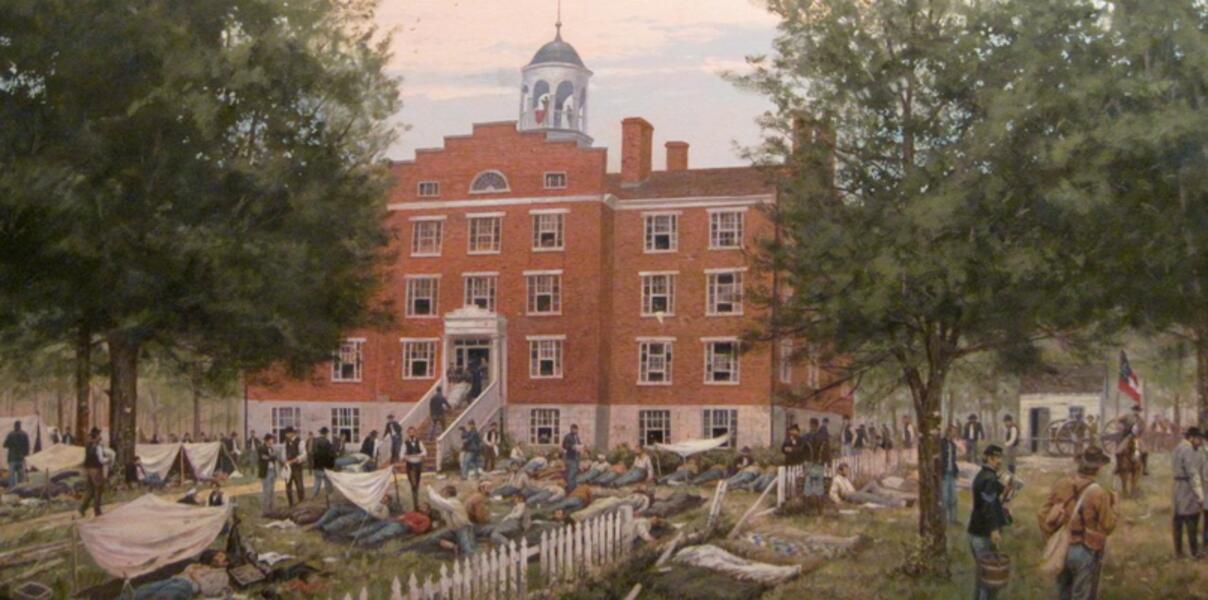 Lutheran Theological Seminary, Gettysburg, site of first day of Battle. Dale Gallon, artist.The scenes in "Citizens at the Crossroads" occur in The Lutheran Theological Seminary, now the Seminary Ridge Museum of Gettysburg. The Seminary, which was the site of the first day of battle, became a defacto hospital with over 600 wounded soldiers.
Lutheran Theological Seminary, Gettysburg, site of first day of Battle. Dale Gallon, artist.The scenes in "Citizens at the Crossroads" occur in The Lutheran Theological Seminary, now the Seminary Ridge Museum of Gettysburg. The Seminary, which was the site of the first day of battle, became a defacto hospital with over 600 wounded soldiers. -
Seminary Ridge Museum, setting for “Citizens at the Crossroads”Scenes are staged in the museum’s exhibition rooms, using the realistic sets as backdrops to convey the horrors of the war
-
Citizens at the CrossroadsActors portray local residents who survive the aftermath of the Battle of Gettysburg. They tell their story inside the museum’s exhibition rooms, using the realistic sets as backdrops to convey the horrors of the war.
Henrietta Szold, A Life
Henrietta Szold: A Life tells the story of an extraordinary Jewish woman, Henrietta Szold. Born and raised in Baltimore, Henrietta Szold was a woman of vision, determination, intelligence, and an unswerving commitment to Judaism and Zionism. Of her many accomplishments, perhaps her greatest legacy was the founding of Hadassah, an American Jewish volunteer women's organization that now numbers 330,000 members. Hadassah raised funds for medical care for Jews and Palestinians in the 1910s and 1920s, and was responsible for rescuing thousands of Jewish youth from the grip of the Nazis.
The Jewish Museum of Maryland commissioned me to write and direct this compelling one-woman show, featuring a powerful local actress, Natalie Pilcher.
For a closer look at the play, see the attached excerpts from Scenes 1 and 2.
The Jewish Museum of Maryland commissioned me to write and direct this compelling one-woman show, featuring a powerful local actress, Natalie Pilcher.
For a closer look at the play, see the attached excerpts from Scenes 1 and 2.
-
 "Henrietta Szold: A Life" at the Jewish Museum of Maryland“Henrietta Szold: A Life” tells the story of an extraordinary Jewish woman with vision, determination, and a life-long commitment to Judaism and Zionism. She founded Hadassah, raised funds for medical care, and helped rescue thousands of Jewish youth from the Nazis. Performed at the Jewish Museum of Maryland.
"Henrietta Szold: A Life" at the Jewish Museum of Maryland“Henrietta Szold: A Life” tells the story of an extraordinary Jewish woman with vision, determination, and a life-long commitment to Judaism and Zionism. She founded Hadassah, raised funds for medical care, and helped rescue thousands of Jewish youth from the Nazis. Performed at the Jewish Museum of Maryland.
Swallowing the Yellow Dog
“Swallowing the yellow dog” was a term used during the Civil War by Confederate prisoners. It meant renouncing the Confederacy and becoming a “galvanized Yankee” by pledging allegiance to the Union. It also meant getting a little more food while imprisoned.
The play Swallowing the Yellow Dog explores the dilemma that southern prisoners faced while incarcerated at Fort Delaware during the Civil War. Conditions at the Fort, which housed thousands of Confederate soldiers, were incredibly harsh by any standards. The play centers on one prisoner who considers whether or not to “swallow the yellow dog” and pledge allegiance to the Union. He lived in the south only briefly, was conscripted by the Confederate army, and is repelled by the horror of war and death at Gettysburg. His friend, a born southerner and staunch Confederate, tries to dissuade him.
Fort Delaware commissioned this play because they found that many visitors who toured the reconstructed barracks at the fort did not have enough understanding of the prisoners’ situation to meaningfully interact with their interpretive staff. The play, based on actual diaries and letters from the time, accomplished its goal – visitors stayed longer onsite, pondered what they would do if they were in a similar situation, and asked more relevant questions that broadened their own understanding.
See the attached excerpt from Swallowing the Yellow Dog to read more about the Fort Delaware prisoners and their dilemma.
The play Swallowing the Yellow Dog explores the dilemma that southern prisoners faced while incarcerated at Fort Delaware during the Civil War. Conditions at the Fort, which housed thousands of Confederate soldiers, were incredibly harsh by any standards. The play centers on one prisoner who considers whether or not to “swallow the yellow dog” and pledge allegiance to the Union. He lived in the south only briefly, was conscripted by the Confederate army, and is repelled by the horror of war and death at Gettysburg. His friend, a born southerner and staunch Confederate, tries to dissuade him.
Fort Delaware commissioned this play because they found that many visitors who toured the reconstructed barracks at the fort did not have enough understanding of the prisoners’ situation to meaningfully interact with their interpretive staff. The play, based on actual diaries and letters from the time, accomplished its goal – visitors stayed longer onsite, pondered what they would do if they were in a similar situation, and asked more relevant questions that broadened their own understanding.
See the attached excerpt from Swallowing the Yellow Dog to read more about the Fort Delaware prisoners and their dilemma.
A Taste of Freedom: Black Sailors in the War of 1812
"A Taste of Freedom: Black Sailors in the War of 1812," is a one-man performance about black sailors, as well as a story about freedom. Or actually, just a taste of it. Since a “black jack” took the same risks and abuse and tolerated the same horrible conditions as white sailors, he was equal to his shipmates in many respects. He traveled, met new people, and got to see the sites at ports throughout the world. People respected him. Sometimes, he even commanded a ship. But he was still enslaved. And he didn't have his freedom. He had just a taste of it. This is his story.
To read an excerpt from "A Taste of Freedom," please see the attachment.
To read an excerpt from "A Taste of Freedom," please see the attachment.
-
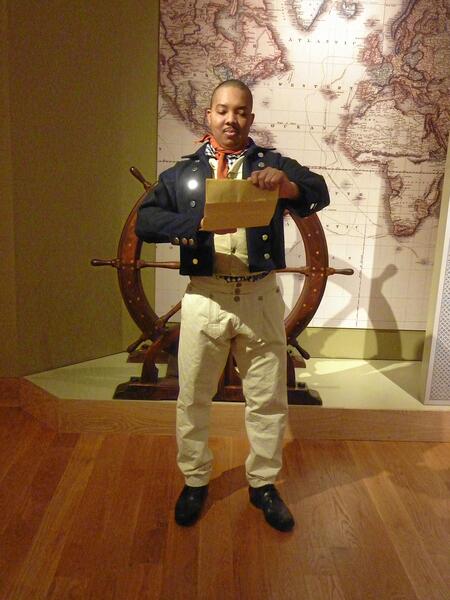 A Taste of Freedom: Black Sailors in the War of 1812Actor reads proclamation from British offering freedom to enslaved black Americans
A Taste of Freedom: Black Sailors in the War of 1812Actor reads proclamation from British offering freedom to enslaved black Americans -
 A Taste of Freedom: Black Sailors in the War of 1812"A Taste of Freedom: Black Sailors in the War of 1812," is a one-man performance about black sailors, as well as a story about freedom.
A Taste of Freedom: Black Sailors in the War of 1812"A Taste of Freedom: Black Sailors in the War of 1812," is a one-man performance about black sailors, as well as a story about freedom.
